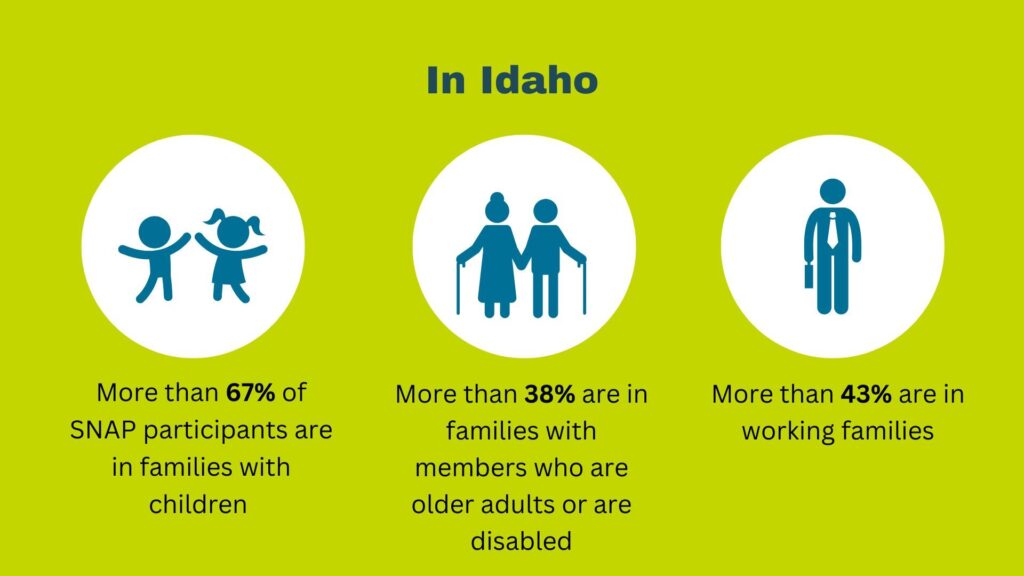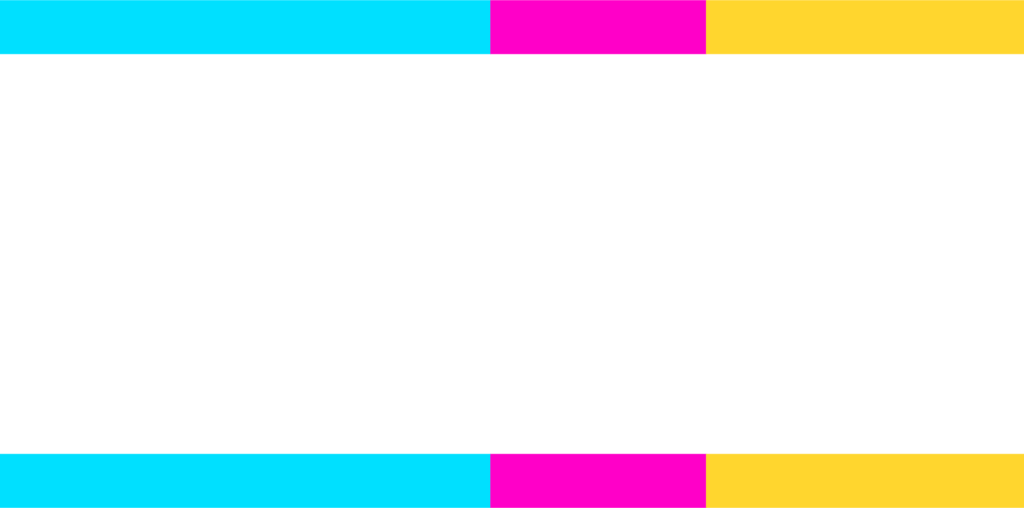On May 22, the U.S. House of Representatives approved a federal budget package that eliminates $300 billion from the Supplemental Nutrition Assistance Program (SNAP), which is a 30 percent reduction of the program’s funding. The bill reflects the largest cut to SNAP funding in its history and shifts a significant share of the program’s cost to Idaho’s state budget. The cuts will result in tens of thousands of Idahoans losing SNAP, increasing costs for already struggling Idaho families, weakening the state’s ability to respond to economic downturns, and worsening hunger across the state.
SNAP Effectively Combats Hunger in Idaho
The Supplemental Nutrition Assistance Program is the nation’s largest hunger relief program; it is highly effective at reducing hunger and poverty. SNAP provides food assistance to over 130,000 Idahoans who are food insecure – meaning those who don’t have enough to eat and don’t know where their next meal will come from.1 Ninety percent of households who receive SNAP benefits in Idaho are households with children, elderly adults, or people with disabilities.2

Cost Shifts Will Put Idaho on the Hook for as Much as $70 Million Annually
Since the SNAP program was established in its current form almost 50 years ago, the federal government has covered 100 percent of food benefit costs and 50 percent of administrative costs. The House budget package seeks to fundamentally alter the funding structure of SNAP by requiring states to pay a portion of food benefit costs for the first time and increasing the administrative contribution. The cost share provision included in the budget package would require states to pay between 5 and 25 percent of the state’s food benefit costs starting in 2028. This amount would be determined by an individual state’s combined error rate, which measures the accuracy of each state’s eligibility and benefit determinations and fluctuates year-to-year.3
As indicated in the chart below, states with an error rate below 6 percent would owe 5 percent of the food cost benefit; states with an error rate of 6 to 8 would owe 15 percent; states with an error rate of 8 to 10 would owe 20 percent; and states with an error rate exceeding 10 percent would owe 25 percent. The likely fluctuation of error rates will place an element of strain and uncertainty on Idaho’s state budget.
Last year, SNAP provided $281 million in food assistance to Idaho families.4 The additional cost sharing requirement would put the State of Idaho on the hook for an estimated annual cost-share of $14 million to $70 million annually to cover the state’s portion of the food benefit, which is an expense Idaho’s budget is not poised to handle – especially in light of the Idaho Legislature’s recent string of income tax cuts over the last five years.5
Additional SNAP provisions in the budget package would allow state lawmakers to consider implementation of harmful program changes to lower costs, such as cutting eligibility, making it more difficult for Idahoans to enroll, or even opting out of SNAP entirely. Any of these program changes would negatively impact Idaho families, businesses, and the economy.
New Red Tape Will Interfere with Idahoans Receiving Food Assistance
The House budget package also shifts administrative costs to the states – from the current rate of 50 percent to a new rate of 75 percent – while simultaneously increasing administrative requirements. As a result, it is very likely states will owe higher cost shift penalties over time as error rates rise. The package also includes an expansion of SNAP’s harmful and ineffective work requirements, adding yet another administrative burden that would take food away from Idaho’s families with children, older adults, veterans, and others. Under the current policy, most adults between the ages of 18 and 54 without children in the household can only receive food benefits for three months out of a three-year period unless they comply with the 20-hour-per-week work requirement.6 The House budget bill seeks to expand this population to also include adults aged 55 to 64 and adults living with children aged 7 or older. As a result, an estimated 8,000 adults between the ages of 18 and 64 could lose their food benefits entirely. Another 21,000 Idahoans – including many children – could see their food benefits significantly reduced.7
The expansion of these work requirements increases the likelihood of states experiencing higher error rates as states are put on the hook for additional administrative responsibilities. Further, these harsh work requirements remain in effect despite little evidence suggesting they improve employment opportunities or outcomes.
Conclusion
The U.S. Senate must reject the House budget bill’s SNAP cuts in order to support a healthy and thriving Idaho. Our communities thrive when our neighbors have access to basic necessities and the assistance they need to attain financial self-sufficiency. Children experience better health, education outcomes, and quality of life when they have access to nutritious and consistent food.
The SNAP provisions included in the House budget bill are harmful for Idaho’s children, seniors, Idahoans with disabilities, working families, businesses, and overall economy. These higher costs will be hard for Idaho to shoulder even when times are good, let alone now as finances are under growing strain and the economy is flashing warning signs of uncertainty. In response to these added costs, Idaho lawmakers would have to either raise taxes or be forced to cut back on vital health care and food assistance, as well as investments in a range of other public goods – like schools and roads – since the state is required to balance its budget annually. Regardless of the choices made by our state lawmakers, these cost shifts will be made at the expense of the wellbeing of Idahoans.
Endnotes
- Center on Budget and Policy Priorities. January 2025. “Idaho: Supplemental Nutrition Assistance Program.” Accessed at: https://www.cbpp.org/sites/default/files/atoms/files/snap_factsheet_idaho.pdf ↩︎
- No Kid Hungry. 2024. “SNAP in Idaho: The Supplemental Nutrition Assistance Program.” https://bestpractices.nokidhungry.org/sites/default/files/2024-01/SNAP%20in%20Idaho.pdf ↩︎
- U.S.D.A. Food and Nutrition Service. 2024. ”SNAP Payment Error Rates.” Accessed at: https://www.fns.usda.gov/snap/qc/per ↩︎
- Dottie Rosenbaum, Katie Bergh, and Wesley Tharpe. March 21, 2025. Accessed at: https://www.cbpp.org/research/food-assistance/imposing-snap-food-benefit-costs-on-states-would-worsen-hunger-hurt-states ↩︎
- Katie Bergh & Dottie Rosenbaum. May 13, 2025. ”House Agriculture Committee Proposal Would Worsen Hunger, Hit State Budgets Hard.” Accessed at: https://www.cbpp.org/research/food-assistance/house-agriculture-committee-proposal-would-worsen-hunger-hit-state-budgets ↩︎
- Katie Bergh, Dottie Rosenbaum, and Wesley Tharpe. May 28, 2025. Accessed at: https://www.cbpp.org/research/food-assistance/house-reconciliation-bill-proposes-deepest-snap-cut-in-history-would-take ↩︎
- Katie Bergh, Dottie Rosenbaum, and Wesley Tharpe. May 28, 2025. Accessed at: https://www.cbpp.org/research/food-assistance/house-reconciliation-bill-proposes-deepest-snap-cut-in-history-would-take ↩︎


